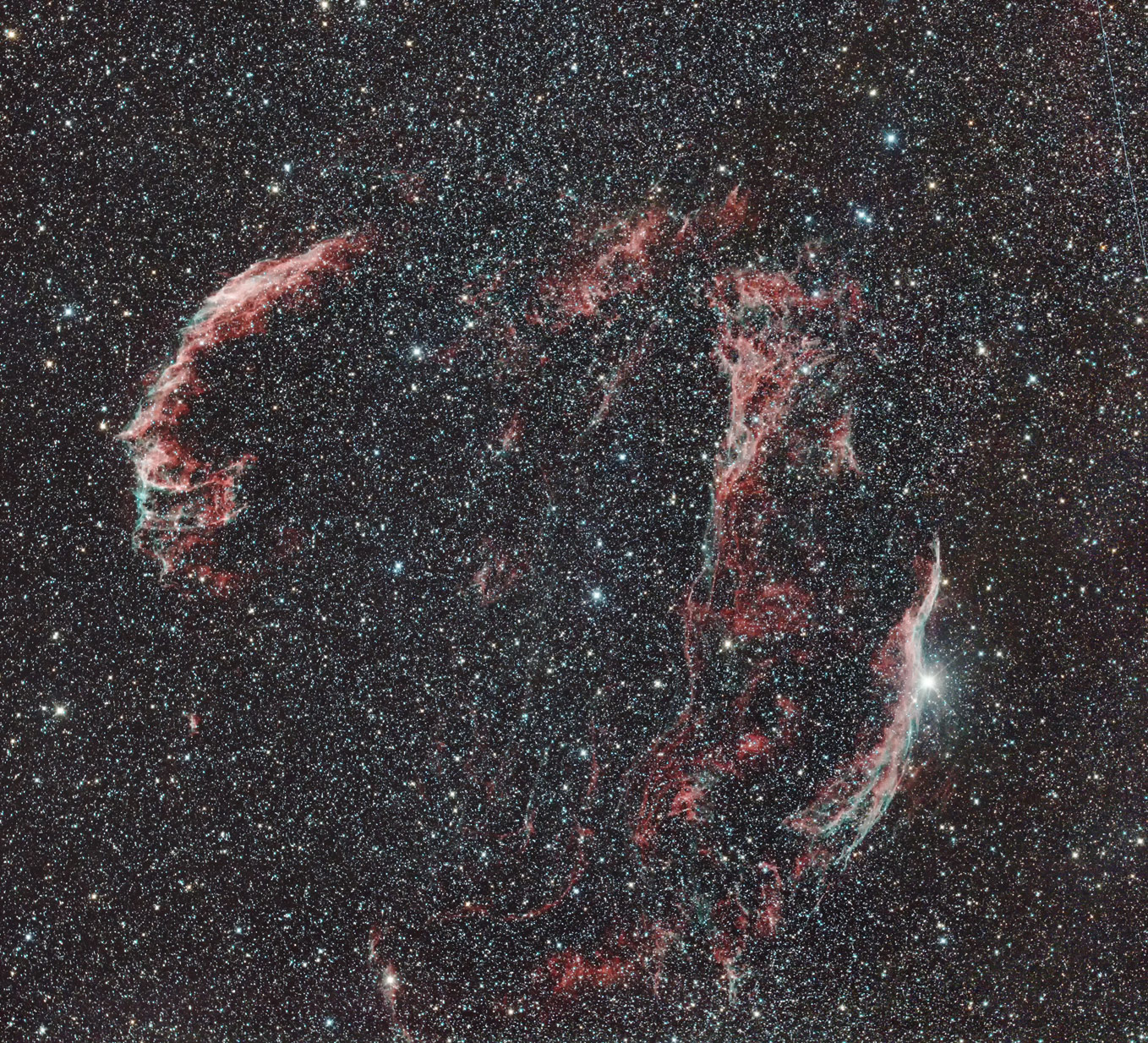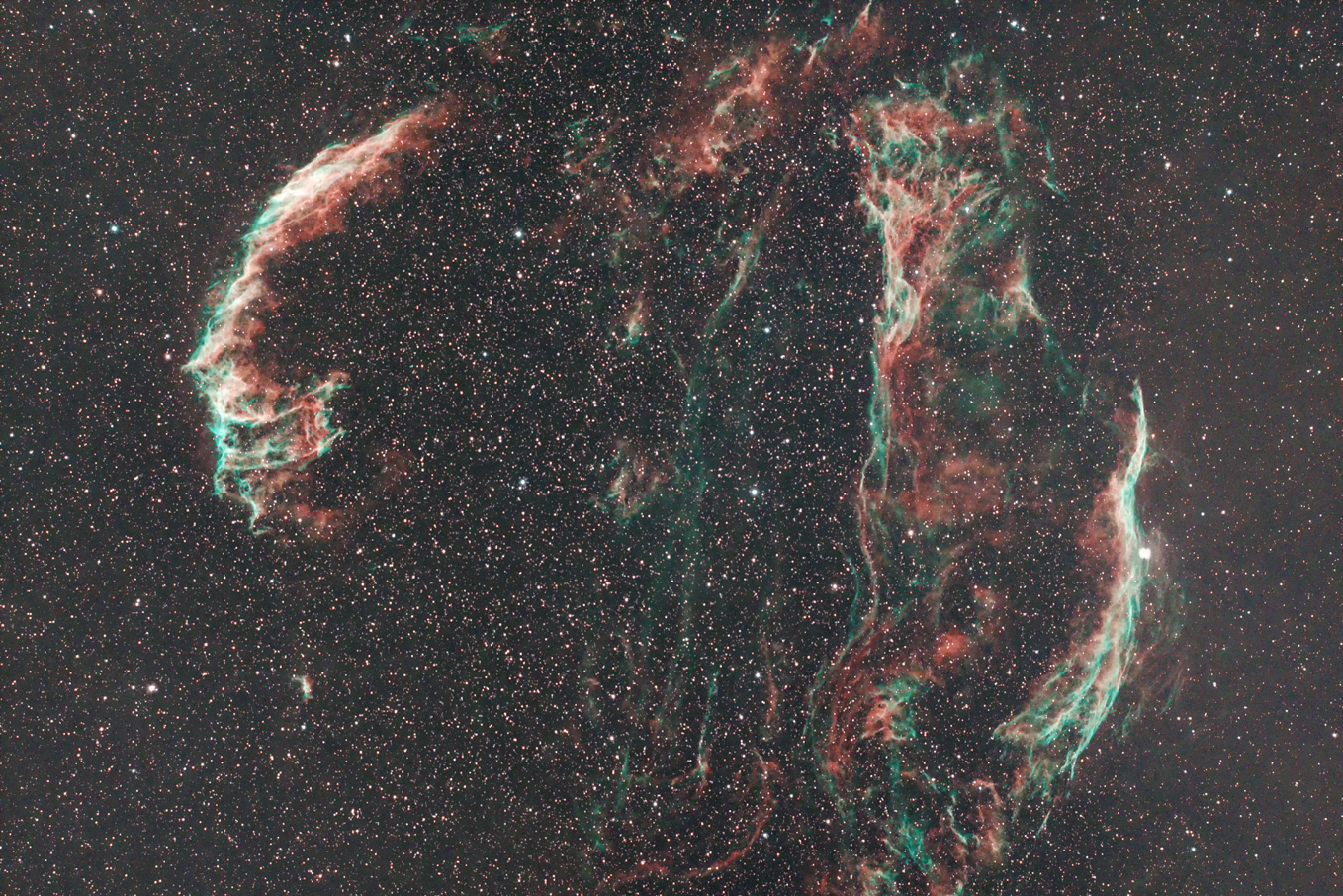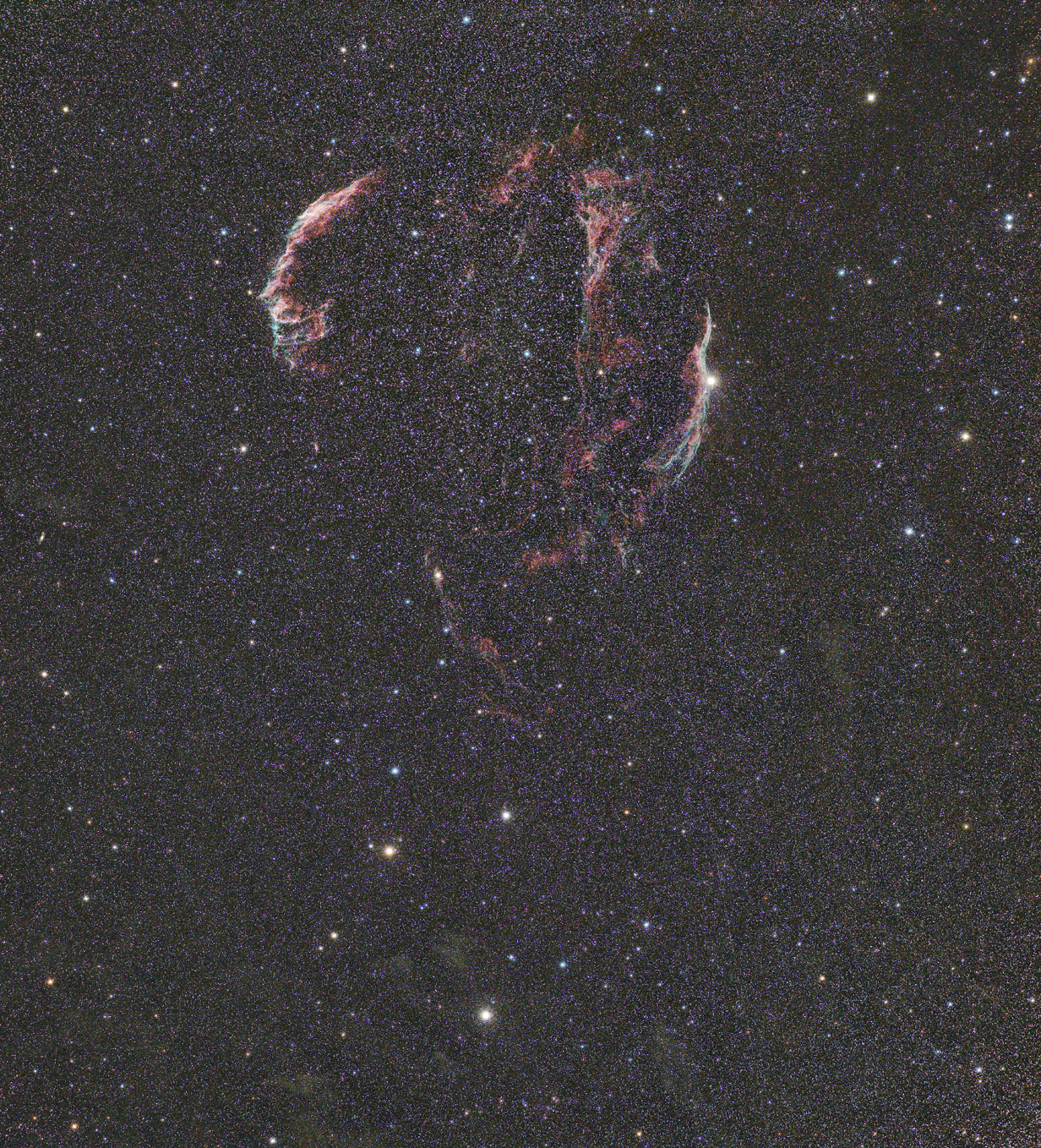Deep Sky Object in Summer
Veil Nebula (NGC6992-5 in Cygnus)
Click on image to enlarge
| Date & Time: | Apr 29 2017, from 26:13 to 27:22 JST(+0900) |
| Mosaic of 2 flames of 6min.×6shots |
| Optical: | TAKAHASHI 16cm(6.3") epsilon (f=530mm, F3.3) |
| with IDAS LPS-D1 Light-pollution suppression filter |
| Auto-guided with TAKAHASHI JP Equatorial & SBIG STV |
| Digital Camera: | Canon EOS 6D (Remodeled) |
| Location: | Ooizumi, Hokuto city, Yamanashi pref. |
| Camera Settings: | Recording format...14bit CCD-RAW, converted to 16bit TIFF(5472×3648) |
| Device Size...35×24mm, Sensitivity...ISO1600 |
Click on image to enlarge
Veil Nebula through narrowband filter
| Date & Time: | Oct 6 2023, from 19:53 to 21:17 JST(+0900) |
| Composed 8 shots with 12 minutes exposed |
| Optical: | PENTAX 7.5cm(2.9") ED refractor with a conversion lens (f=360mm, F4.8) |
| with SIGHTRON Quad BP III filter |
| Auto-guided with TAKAHASHI JP Equatorial & SBIG STV |
| CMOS Camera: | ZWO ASI2600MC Pro (Cooled temp.: -15°C) |
| Location: | Ooizumi, Hokuto city, Yamanashi pref. |
| Camera Settings: | Recording format...16bit FITS, converted to 16bit TIFF(6248×4176) |
| Device Size...23.5×15.7mm, Gain...100 |
Click on image to enlarge
Wide-field image of Veil Nebula
| Date & Time: | Jul 9 2016, from 25:12 to 26:10 JST(+0900) |
| Mosaic of 2 flames of 4min.×6shots |
| Optical: | BORG 67FL, with a conversion lens (f=324mm, F4.8) |
| with BaaderPlanetarium Moon&Skyglow filter |
| Auto-guided with TAKAHASHI JP Equatorial |
| Digital Camera: | Canon EOS 6D (Remodeled) |
| Location: | Ooizumi, Hokuto city, Yamanashi pref. |
| Camera Settings: | Recording Format...14bit CCD-RAW, converted to 16bit TIFF(5472×3648) |
| Device Size...35×24mm, Sensitivity...ISO1600 |
| NGC6992-5 / Diffused Nebula, type E |
|---|
| R.A. | 20h 56m 24.0s (2000.0) |
|---|
| Dec. | +31° 43' 00" (2000.0) |
|---|
| Apparent Size | 78×8' |
|---|
| Real Size | 29.5×3.0 light yrs. |
|---|
| Magnitude | - |
|---|
| Distance | 1300 light yrs. |
|---|
| Other IDs | IC1340 |
|---|
|
| NGC6960 / Diffused Nebula, type E |
|---|
| R.A. | 20h 45m 42.0s (2000.0) |
|---|
| Dec. | +30° 43' 00" (2000.0) |
|---|
| Apparent Size | 70×6' |
|---|
| Real Size | 26.5×2.3 light yrs. |
|---|
| Magnitude | - |
|---|
| Distance | 1300 light yrs. |
|---|
|
Veil Nebula is a faint and vast loop spread at the south wing of swan, consists of east (NGC6992-5) and west (NGC6960) segments.
They are fine filaments seemingly suspended in the space.
East Side is brighter, and can be seen with binoculars in perfect conditions.
The star 52 Cygni is in the same field as the western part, and a dimmed and vast cloud of NGC6979 is spread between these nebulae.
It's considered that the nebula is a remnant of supernova exploded over ten thousand years ago, and is expanding outward with a velocity of about 100km (62 miles) per second.
This elusive nebula has a real size of about 50 light years and a distance of 1300 light years.
The second image is a photograph taken through a narrowband filter.
The Veil Nebula consists of intricate intertwining of red Hα light and green OIII light-emitting nebulae.
In the vicinity of NGC6979, which stretches between NGC6992-5 on the east (left side of the photo) and NGC6960 on the west (right side),
a very faint OIII component is distributed in a streak-like pattern in the north-south direction.
The third wide-field image has captured around the Veil Nebula with a span of about 6.3°×7.0°.
You can see a small piece of nebula has been floating apart in south around center of the image.
This field is equivalent to eastern edge of the Milky Way, uncountable fine stars are dustributed without a break.
This image shows several dimmed lumps of molecular clouds around southern edge (lower part) of the field.
Jump to Close-up of NGC6960(169KB)
Jump to Close-up of NGC6992-5(132KB)
|



